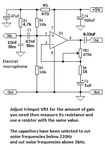cybertron
Member level 3

Hi all
I am using the 9170 dtmf decoder chip.
What i need to know? If I use 5.0V or 3.6V to power this chip.
1.What would the voltage and the output current be on pin 15 with a power supply of 5.0V.
With or with a valid tone
2. What would the voltage and the output current be on pin 15 with a power supply 3.6V.
With or with out a valid tone
Also there will be an NPN switching transistor BC549 to turn on an LED for detecting a Valid
tone on the output of pin 15 . If there IS no tone the LED stay's off.
If there is a Valid tone the current turns on the transistor then turns on the LED.
The LED is a froward voltage of 1.6V for it to turn on.Using a 470 resisto
https://www.digikey.com/product-detail/en/BC549BTF/BC549BTFCT-ND/4744184 DATASHEET-LINK?
What value of resistor would I use for the Base of the transistor. for 5.0V power supply
What value of resistor would I use for the Base of the transistor. for 3.6V power supply
I am using the 9170 dtmf decoder chip.
What i need to know? If I use 5.0V or 3.6V to power this chip.
1.What would the voltage and the output current be on pin 15 with a power supply of 5.0V.
With or with a valid tone
2. What would the voltage and the output current be on pin 15 with a power supply 3.6V.
With or with out a valid tone
Also there will be an NPN switching transistor BC549 to turn on an LED for detecting a Valid
tone on the output of pin 15 . If there IS no tone the LED stay's off.
If there is a Valid tone the current turns on the transistor then turns on the LED.
The LED is a froward voltage of 1.6V for it to turn on.Using a 470 resisto
https://www.digikey.com/product-detail/en/BC549BTF/BC549BTFCT-ND/4744184 DATASHEET-LINK?
What value of resistor would I use for the Base of the transistor. for 5.0V power supply
What value of resistor would I use for the Base of the transistor. for 3.6V power supply


